Creation Science Articles
Creationist Misuse of the Green River Formation
Copyright 2003 G.R. Morton. This can be freely distributed so long as no changes are made and no charges are made.
Answers in Genesis recently published an article concerning the Green River Formation on their web site. The article, by Paul Garner, purports to show how the Green River formation can be deposited by a global flood.. The article can be found at:https://answersingenesis.org/geology/catastrophism/green-river-blues/ This article is a response to the nonsense on that paper.
Background on Green River Formation
One needs some background on the regional geology in order to understand the issues. The Green River Formation lies in southwestern Wyoming, northwestern Colorado and extreme northeastern Utah. It is found in three different ancient lake basins. The first is Lake Gosiute which consists of the Green River Formation found in the Green River Basin, the Washakie Basin, and the Sand Wash Basin (all of which used to interconnect but presently don't due to erosion). The Green River Formation is also found in the ancient Fossil Lake in the Fossil Basin, which lies to the west and which does not connect up with Lake Gosiute. As we shall see there is even paleontological evidence that these basins never connected. Finally the Green River Formation is found in Lake Uinta in the Uinta and Piceance Basins to the south of the map. These three ancient lakes were separated from each other and when speaking of the Green River, one must be careful to distinguish where one is talking about. Blindly applying discoveries from one ancient lake to another or to the Green River in general leads creationists to erroneous conclusions. Below are two maps showing the location of these basins. The first is from Bradley (1929, p. 89) and shows a more regional view. The second (modified from R. Sullivan, 1985, p. 914) zooms in on Fossil Lake and Lake Gosiute.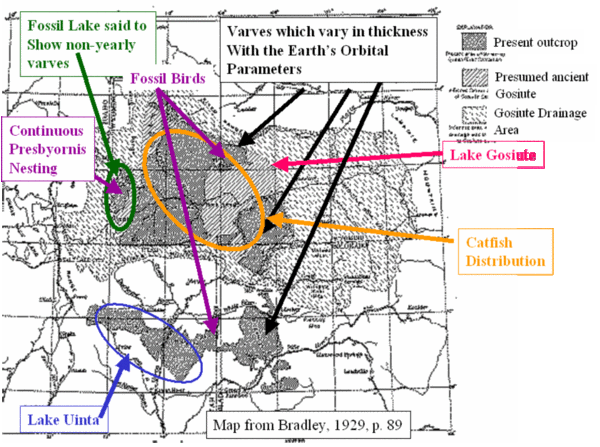
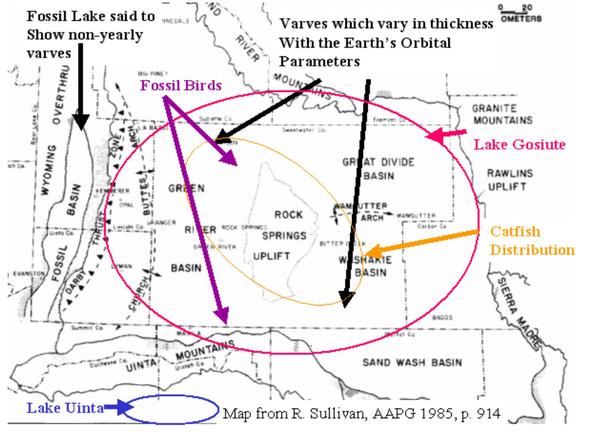
The thickness of the Green River Formation varies between each basin and within each basin. The thickest parts of the Green River Formation in Lake Gosiute are in the neighborhood of 200-2600 feet. But this is not all the sediment found in these basins. There is approximately 30,000 feet of sediments in these basins (variable of course; see McPeek, 1981, p. 1080 Fig 3), 28,000 of which underlies the Green River Formation. This is important to know when one is trying to explain the Green River Formation as the result of a global flood because both the Green River Formation and the underlying sediment must be flood deposited rocks. The flood must have deposited 28,000 feet of sediment before the Green River Formation was deposited!
Wilmot Bradley was the first to publish extensively on the Green River Formation (or at least was the most influential). He noted that the formation has rhythmic laminations in four different rock types. These are: "organic marlstone or low-grade oil shale, moderate-grade oil shale, rich oil shale, and fine-grained limy sandstone" (Bradley, 1929, p. 95). He noted that the various types of lamina show varying rates of deposition. He notes that the varves "range in thickness from 0.014 millimeter in the beds of richest oil shale to 9.8 millimeters in the fine-grained sandstone. The average thickness, weighted according to the quantity of each type of rock in the Green River formation, is about 0.18 millimeters." (Bradley, 1929, p. 96). He placed the rates of deposition in a table showing the rates of deposition of the various types of laminated rocks (Bradley, 1929, p. 99):
| Varve average (millimeters) |
Time to accumulate 1 foot (years) |
|
| Sandstone, fine grained |
1.16 |
250 |
| Marlstone |
0.167 |
2,000 |
| Moderate oil shale |
0.065 |
4,700 |
| Rich oil shale |
0.037 |
8,200 |
| Weighted average |
0.18 |
2,200 |
- "This section is about 2,600 feet thick and consists of about 7 per cent of fine-grained sandstone, about 76 per cent of marlstone and closely related rocks, about 13 percent of oil shale that will probably yield between 15 and 35 gallons of oil to the ton, about 4 per cent of oil shale that will yield more than 35 gallons to the ton, and a negligible quantity of algal limestone and oolite. The rates of accumulation already assumed are as follows: Fine-grained sandstone, 1 foot in 250 years; marlstone and related rocks, 1 foot in 2,000 years; oil shale yielding between 15 and 35 gallons to the ton, 1 foot in 4700 years; and oil shale yielding more than 35 gallons to the ton, 1 foot in 8,200 years. According to these rates the Green River epoch is estimated to have lasted about 6,500,000 years." (Bradley, 1929, p. 107).
This means that this part of the Green River has 13 million layers. Depositing this many layers in a one year global flood is problematic, especially when one considers the nature of the material being deposited. Bradley (1929, p. 100-101) tells us:
- "The greater part of the organic matter presumably came down as a rain of minute planktonic organisms which might have ranged from 1 or 2 microns to several millimeters in maximum dimension, though if an analogy with Lake Mendota in Wisconsin is significant it might be inferred that most of the organisms were less than 60 microns in diameter. . . ."
- "It is reasonable to believe that the precipitation of carbonates accompanied the sedimentation of the remains of plankton organisms. And if the assumptions are made that organisms and carbonate grains began to settle from the same water stratum, that the particles of both sorts of material settled as spheres, that the carbonate grains averaged about 5 microns in diameter (their present size), and that the organisms averaged about 50 microns in diameter and had an average specific gravity of 1.05, then the variables of Stokes law show that the carbonate grains, despite their small size, must have settled many times more rapidly than the lighter organic matter. Consequently there would have been complete separation of the constituents into two layers even in shallow water."
Particles with a 5 micron diameter will require many days to settle out of the water. Thus, each organic-rich layer is in itself evidence of several days duration. The table below is reproduced fromhttp://www.civil.mtu.edu/~nurban/classes/ce503c/1999/proj1bsol.html .
The table is based upon a similar density to what we find in the Green River Formation, the inorganic particles are 2.5 g/cc and the organic 1.05 g/cc. Given that Bradley said that the carbonate particles were 5 microns and the organic particles were around 50 microns we see from the table below that such particles settle at 1.9 meters/day and 5 meters per day, respectively
|
Diameter (μm) |
Settling velocity (m/d) for inorganic particles |
Settling velocity (m/d) for organic particles |
|
600 |
19,424 |
651 |
|
425 |
9,745 |
327 |
|
300 |
4,856 |
163 |
|
213 |
2,448 |
82.1 |
|
150.5 |
1,222 |
41.0 |
|
106.5 |
612 |
20.5 |
| 75 |
304 |
10.2 |
| 53 |
152 |
5.08 |
|
37.5 |
75.9 |
2.54 |
|
26.5 |
37.9 |
1.27 |
| 19 |
19.5 |
0.653 |
|
13.5 |
9.83 |
0.330 |
|
9.4 |
4.77 |
0.160 |
|
6.65 |
2.39 |
0.080 |
|
4.7 |
1.19 |
0.040 |
|
3.35 |
0.605 |
0.020 |
|
2.35 |
0.298 |
0.010 |
|
1.65 |
0.147 |
0.005 |
|
1.15 |
0.071 |
0.002 |
|
0.45 |
0.011 |
0.0004 |
With this as a background we can now evaluate Paul Garner's article.
Catfish
Garner (1997) writes:
"However, the critics (who in any case err by relying on the incomplete data of fallible scientists, rather than the infallible God who knows all data) leave out some vital information that sheds light on the origin of 'varves'. As long ago as 1961, creationists were pointing out features of the Green River Formation that were difficult to reconcile with the conventional varve interpretation.5 For instance, well-preserved fossils are abundant and widespread throughout the sediments. According to two conventional geologists:
- . . . fossil catfish are distributed in the Green River basin over an area of 16,000 km2 . . . The catfish range in length from 11 to 24 cm, with a mean of 18 cm. Preservation is excellent. In some specimens, even the skin and other soft parts, including the adipose fin, are well preserved.6 "
There are several things wrong with the above. First, the catfish are limited in areal extent to the center of Lake Gosiute. They are not found everywhere. Fossil Lake has no catfish whatsoever. Paul Buchheim writes (Grande and Buchheim, 1994, p. 45):
- "It is important here to mention certain fishes lacking in the F-1, F-2 and Warfield Springs deposits (and all of the Fossil Butte Member deposits, as far as we know), because of their abundance in the Laney Member Green River Formation deposits of neighboring Lake Gosiute. Most conspicuously there is an absence of suckers (Catostomidae) and catfishes (Ictaluridae and Hypsidoridae) from the Fossil Lake deposits, two major groups of bottom-dwelling fishes that are abundant in the Lake Gosiute deposits. No sucker has ever been reported from Fossil Lake. The first author previously reported catfishes as being extremely rarely known from Fossil Lake based on a photograph of a single partial specimen (probably from near shore F-2). But neither of us has ever seen another trace of catfish from the Fossil Lake deposits in the field or in any museum. Thus, catfishes were probably not a normal part of the fauna. Also lacking in the Fossil Butte deposits but common in the Laney Member deposits is the clupeid Gosiutichthys and the percopsid Erismatopterus although these families (Clupeidae and Percopsidae) are represented in Fossil Lake deposits by Knightia and Amphiplaga"
These faunal differences are indicative that the two lakes were indeed separated when the Green River was formed. Because of this, one simply can't take an observation applicable to one part of the Green River Formation and use it everywhere.
The second thing wrong with Garner's statement is that fossil catfish are not found even throughout all of the Lake Gosiute deposits. As shown on the map above, the catfish are known from the deeper parts of the Lake Gosiute, i.e., the parts of the lake furthest from shore. This is an important factor to remember because the fossils are arranged in an areal fashion which fits with a lake deposit, not with a global flood. One knows that the fossil catfish spent a lot of time in the lake because they left lots of catfish coprolites (fossilized dung) in the layers of the Green River Formation. Buchheim and Surdam (1977, p. 198) note that these fish coprolites are extremely numerous at between 100 and 350 per square meter averaging 1 centimeter in length. To concentrate fish coprolites at this density over the reported area of 16,000 sq. kilometers seems to defy any catastrophist interpretation of the beds.
And while Garner is pleased to claim that the catfish are incompatible with the idea of a lake deposit, he totally ignores the fact that the deposit is totally incompatible with a global flood and its requisite transport of sediment and fossils. Buchheim notes in the article that the fish couldnot have been transported. Buchheim and Surdam (1997, p. 198) write:
- "The abundant and widespread occurrence of skeletons of bottom feeders, some with soft fleshy skin intact, strongly suggests that the catfish were a resident population. It is highly improbable that the catfish could have been transported to their site of fossilization. Experiments and observations made on various species of fish have shown that fish decompose and disarticulate after only very short distances of transport."
While I don't have a catfish from the Green River in my collection, I do have some Green River fish which show similar fleshy features as described above. It is shown below.
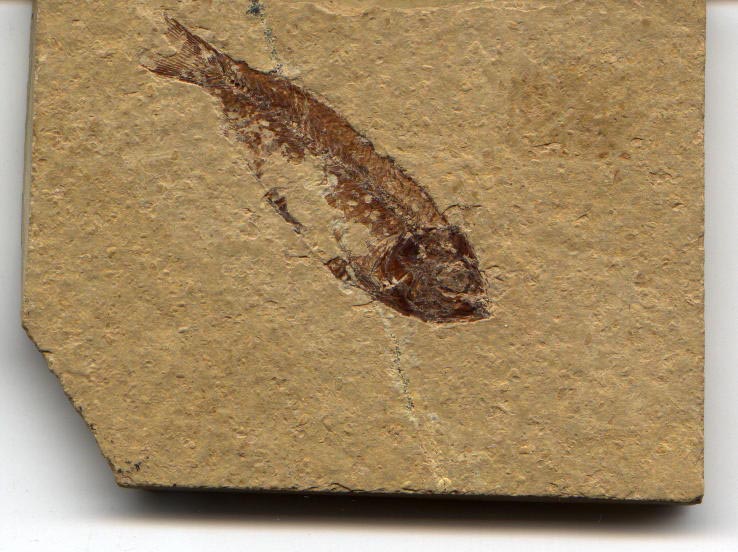
Garner's False Claims About Fossilization
Garner (1997) further criticizes the idea that a normal lake could produce the fossils when he writes:
- "Experiments by scientists from the Chicago Natural History Museum have shown that fish carcasses lowered on to the muddy bottom of a marsh decay quite rapidly, even in oxygen-poor conditions. In these experiments, fish were placed in wire cages to protect them from scavengers, yet after only six-and-a-half days all the flesh had decayed and even the bones had become disconnected.8 "
Garner takes one example where fossilization didn't work, one from an environment which isn't even a lake, and then erroneously applies it to what happens in a lake. I will give an example which contradicts what Garner is saying. I ran into this fascinating account of lake preservation a few years ago. Cotton et al.(1987, p. 1125) write:
- "On 29 Aug. 1983, a lake freighter entered the Duluth, Minnesota harbor. While proceeding to dockage under windy conditions, the captain ordered an anchor be dropped to assure stability. Later when the anchor was raised, the crew was surprised to find an Oldsmobile Toronado impaled on the flukes. The badly damaged and flattened automobile contained the bodies of an adult male and female. The bodies were not easily removed because they were partially compressed and trapped by the flattened automobile body. The time and means by which the automobile was crushed is unknown. It is known, however, that ships commonly lower anchors weighing many tons in the area from which the vehicle was retrieved. It is likely that anchors had previously struck the automobile resulting in the observed damage."
- "Both the vehicle and the deceased persons contained in it were reported missing on 30 Aug. 1978, and, therefore apparently had been submerged exactly five years in the ship canal of the Duluth harbor."
Cotton et al. (1987, p. 1126) note the condition of the bodies and attribute it to the low water temperature.
- "After five years of immersion, these bodies presented the appearance of a superficial shell of adipocere material encasing visceral organs demonstrating a high degree of retention of gross anatomic features but with substantial effacement of histologic structural details."
These people lay on the bottom of a lake for 5 years and were still undecayed. The same process could have taken place with the fish. Thus, Garner has specifically avoided citing examples where tissue preservation has occurred, he gives the totally erroneous impression that fossilization in lakes doesn't and can't occur.
Birds
Garner further claims that the discovery of birds in the Green River formation is terribly problematic for the conventional interpretation. This is absolutely silly and Garner doesn't bother to tell his readers any information about the birds or what was found with them.
First, the birds are found on the shore facies of the lake. This is where they should be found. Secondly, they left numerous footprints, which proves that the waters of Garner's imaginary flood, were no deeper than the legs of the birds. Below are 2 photos courtesy of Bob Elsinger who showed me this fossil at his home in Aberdeen (4-25-03). He kindly e-mailed me the photos; the first is normal footprints, the second is an upper slab showing casts of bird footprints. The birds in this Soldier summit example were small. Their feet were no larger than Bob's wedding ring. Surely one can't reasonably believe that there was a global flood going on at this time. The water depth is hardly that expected of a global flood which deposited 30,000 feet of sediment beneath the Green River.
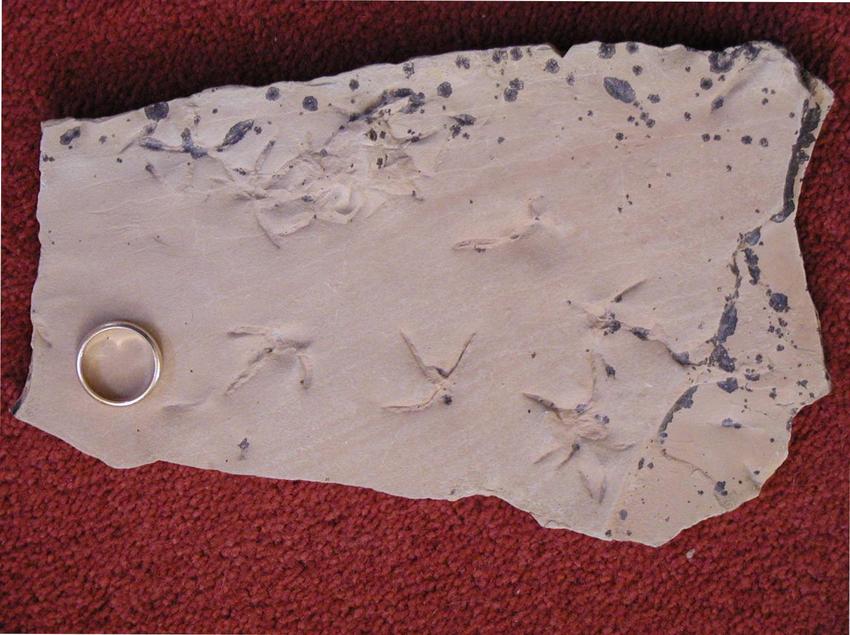
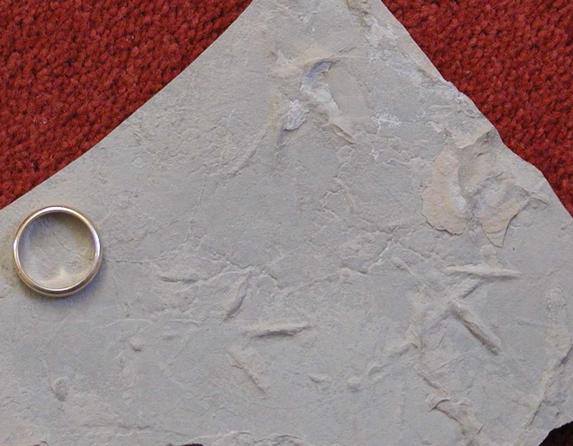
Mounir T. Moussa (1968, p. 1435)notes of the tracks found in the Green River formation in Lake Uinta,
- "The bird tracks are probably those of wading and swimming birds, are of different types, and they show a considerable range in size. Some tracks show a partly developed web, and most of them show a hind toe. According to R. L. Zusi of the U.S. National Museum (written communication, 1965), the bird tracks shown in Plate 177, figure 3, and Plate 178, figures 3 and 5, 'are almost certainly sandpipers, and perhaps plovers, of at least three species."
There are also mammalian tracks. Moussa (1968, p. 1435-1436) writes:
- "The Soldier Summit fossil track horizon also contains mammal tracks which appear to have been made by three-toed mammals; however, these are extremely rare and have been found at three localities only. One locality in the western wall of the canyon of White River in the NE1/4NE1/4 sec. 16 T. 10 S., R. 8 E., has yielded many well-preserved mammal tracks. According to Clayton Ray of the U. S. National Museum, 'It appears that the tracks were made either by a small, three-toed horse, or perhaps a tapiroid, although it would be difficult to identify them with a specific genus."
This area which obviously was in a shallow water, lake edge position also has sedimentologic features suggestive of a lake environment and not a global flood. Moussa (1968, p. 1436) writes:
- "Mud cracks and probable rain-drop impressions are common features in the track-bearing horizon, and very rarely the rocks are ripple marked. The ripple marks are of the oscillation type."
- "The area was probably a part of a near-shore shelf area in the Eocene Uinta Lake, and at that time the lake was apparently characterized by a rapidly vacillating water level."
These features are consistent with the edge of a lake, not a global flood. How on earth are rain-drops and mud-cracks to be preserved when the entire world was under water?
At another bird site, the sedimentologic features further support the lake interpretation. McGrew and Feduccia (1973, p. 163) describe another site which has flamingo-like birds:
- "The fossil bird concentration occurs 104 feet below the base of the basal oil shales of the Laney Shale Member of the Green River Formation in a grayish-green silty claystone. The site is in the S 1/2 sec 24, T 25N, R. 102 W. "
- "Many fragments of aquatic turtle shells and crocodile bones plus fish remains attest to the aquatic environment, and an extensive mud flat submerged under a few feet of water is indicated. Judging from the large number of algal encrusted logs and branches the expanding waters probably drowned a forest. A similar situation exists on Lake Nakuru."
Lake Nakuru is an African lake with lots of flamingos. This site also has evidence that the flamingos weren't washed in to place. They are found with hundreds of thousands of their coprolites. McGrew and Feduccia (1973,p.163-164) observe:
- "Modern flamingos are primarily filter feeders, and the main diet consists of algae and microorganisms obtained from the water and bottom muds. Occasionally, however, flamingos will take a variety of small mollusks, crustaceans, worms and small fish. Stomach contents usually include an abundance of organic muds.
- There is suggestive evidence that the Green River Birds had somewhat similar habits. Within the matrix of the bird quarry, and mixed among the bones were hundreds of small clay pellets. At first these were thought to be coprolites left by small carnivores. Their abundance and composition, however, seemed contrary to that interpretation. The mystery may have been partially solved when we discovered almost identical pellets on the shores of east African Lakes where hundreds of thousands of flamingos concentrated."
Thanks to Bob Elsinger who provided this picture, you can see what the flamingos are like on Lake Nakuru. Thousands of birds would leave millions of feces which would turn into coprolites in the future. This is what happened at Lake Gosiute. And it didn't happen in a global flood! In the picture below, each pink dot is a big flamingo.
And a close-up below.
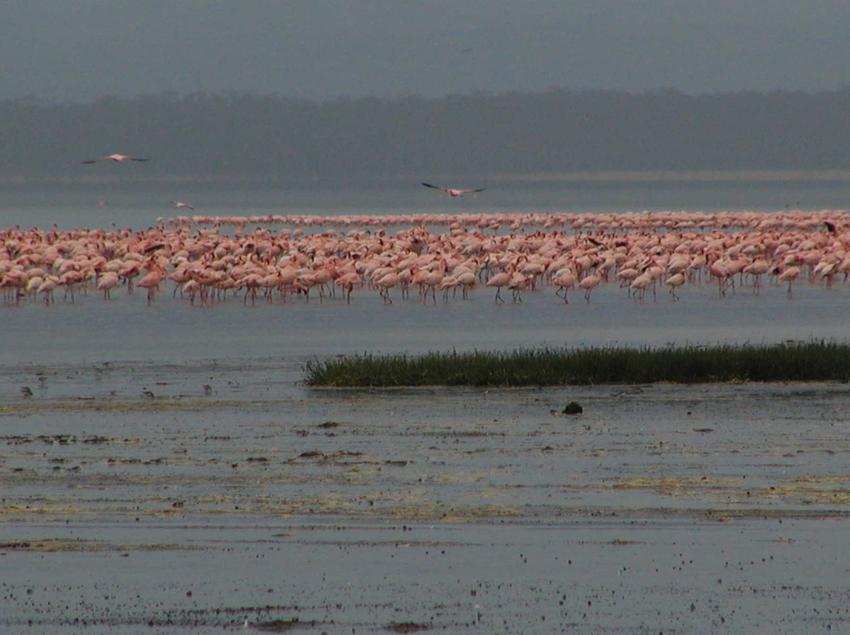
The site was a nesting locale. McGrew and Feduccia further(1973, p. 164) note:
- "That the Green River flamingo locality was a nesting site is proven by the abundant egg shell fragments found among the bones."
One other interesting case of a bird track was that of a duck- or goose-like bird which left evidence of it nibbling (eating). The site was 20 miles south of Provo, Utah. Bruce Erickson (1967) reports that in addition to this track others at slightly different levels (according to the varves) are also found. He writes (Erickson, 1967, p. 146):
-
"One varve may have a thickness of only a few millimeters. In
places it is probable that the like thicknesses of nonvarved
sediments accumulated at similar rates. Tracks found at various
levels then, where vertical separation is only a few
millimeters, are not likely to have been made by one individual
but rather by different individuals during different
times--probably during following or previous seasons depending
on whether they are above or below respectively in the sequence
of layers. The suggestion arises that this 'zone' so productive
of tracks, represents an established habitat for certain species
of birds and was frequented year after year."
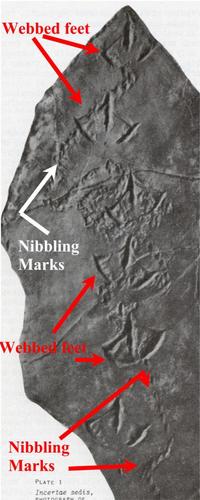
Paul Buchheim acknowledges that birds nested throughout Green River time in Fossil Lake. They studied three different Presbyornis nesting sites and found that they spanned 160 meters of vertical rock. They also commented that such nesting sites are quite common in the shore facies of the Green River Formation. His team writes (Legitt, Buchheim and Biaggi, 1998):
- "Autochthonous Presbyornis sp. (Aves: Anseriformes) eggshell from three Eocene Fossil Lake sites is strong evidence for multiple avian nesting sites within Fossil Basin. Two of these nesting sites (the Bear Divide and Warfield Creek sites) occur near the base of the lower unit of the Fossil Butte Member of the Green River Formation. The third nesting site (the Powerline site) occurs near the top of the upper unit of the Fossil Butte Member. The Presbyornis nesting sites span Green River Formation time in Fossil Basin."
It takes time for a bird to nibble and they don't do it when terrified for their life during a global flood. To believe that the Green River formation is the deposit of a global flood requires one to believe that the fish, with their coprolites, and birds, with their coprolites, eggshells and footprints, were washed into place and arranged so that the catfish are in the center of a circular area surrounded by birds and animal tracks. It is perverse to think that God could have caused a flood which would create deposits which are arranged so that they look like they were not from a global flood.
Life of Caddisflies on the Banks of Lake Gosiute
One of the most amazing finds on the edges of Lake Gosiute are bioherms made up of microbial deposited carbonate on caddisfly larval cases. A bioherm is a buildup of organic material, usually in domal-shaped structures. Some of the caddis-fly bioherms are 9 meters tall and 40 meters in diameter (Leggitt and Cushman, 2001, p. 378). These features are found in a linear trend, 70 kilometers (44 miles) along what was at the time the northern edge of the lake. These bioherms consist of caddisfly pupa cases interlaminated with stromatolite forming microbial-caddisfly couplets. Leggitt and Cushman (2001, p. 383) write:
"The caddisfly larval cases are not randomly arranged within the cores of the columns, but are arranged with the long axes of the cases parallel to each other and normal to bedding. Each bedding plane is one case thick (i.e., about 1 cm). Cases are closely packed and almost touch each other. The smaller caudal end of the slightly tapered case is almost always directed downward (or inward toward the column core). All cases are similar in length (1 cm) and diameter 2.5 mm)."
How do such things form? Drysdale 1999, p. 146) observed:
"In general, Cheumatopsyche larvae collect locally available detrital mineral and vegetable particles and bind them together with silk to form a retreat, an approximately cylindrical tube within which the animal lives and which is anchored to the substratum by silk strands. Calcium carbonate deposited over the anchor points must add considerable stability to these retreats, reinforcing them against erosion during spate conditions. At the opening of the retreat, an elaborate silk net is spun by the larvae to strain food particles from the water column."
The existence of these caddisfly larval cases indicates that time was required for the deposition of this part of the Green River. While it is doubtful that the stromatolite/caddisfly couplets represent a yearly deposit, the fact remains that a global flood would have a great deal of difficulty collecting such small items and arranging them so that their tiny ends all point towards the center of a circular column and do this over and over so that layer after layer can be deposited. Below is a figure from Leggitt and Cushman's article.
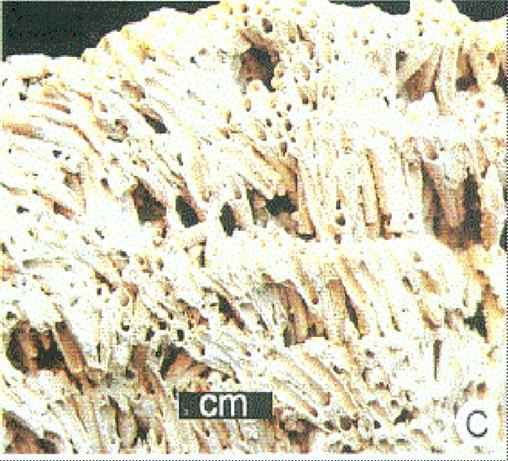
And the YEC must explain why the Flood did this over and over only in a line along the north shore of a deposit which would be interpreted as a lake long after this deposition and not deposit such things anywhere else in the area. One must have a truly flexible mind to hold that such things are deposited by a global flood.
While I don't have an example of a caddisfly pupae interlaminated in a stromatolite, I do have a picture of a green river stromatolite which a friend cut and polished for bookends. You can see the major banding, but what the photo won't show is the even tinier daily banding of the stromatolite in which small layers of limestone are deposited each day.
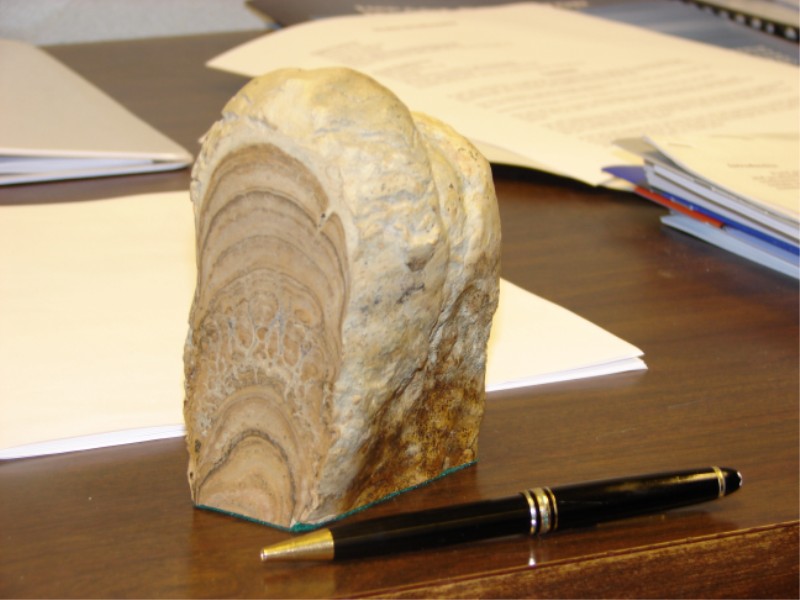
Duration of the Eocene Lakes
Garner further shows that he has not investigated alternative possibilities when he criticises the varves based upon the work of Buchheim and Biaggi. Garner asserts (1997):
- "Creationist suspicions about the validity of the varve interpretation were confirmed in a study by two geologists published in 1988.9 Near Kemmerer in Wyoming the Green River Formation contains two volcanic ash (tuff) layers, each about two to three centimetres thick."
- "A volcanic ash layer is an example of what geologists call an 'event horizon', because it is laid down essentially instantaneously by a single event, in this case a volcanic eruption. The two ash layers are separated by between 8.3 and 22.6 centimetres of shale layers."
- "If the standard interpretation is correct, then the number of shale layers between the ash layers should be the same throughout the Green River basin, since the number of years between the two eruptions would be the same."
- "However, the geologists found that the number of shale layers between the ash beds varied from 1160 to 1568, with the number of layers increasing by up to 35% from the basin centre to the basin margin! The investigators concluded that this was inconsistent with the idea of seasonal 'varve' deposition in a stagnant lake."
Garner makes it look as if secular geologists are coming to the conclusion that there are no varves in the Green River. This is not at all the case. Furthermore, Garner fails to honestly inform his readers that Buchheim's work is in Fossil Lake, the smallest of the ancient lakes and this is an important aspect of what the researchers observed. It is true that they observed more laminations near the shore than out in the lake's center. But they should have and that is what Garner fails to tell his readers.
Fossil lake was about 18 miles long and 12 miles wide. It is found at the Utah/Wyoming border. Gosiute is found to the east of Fossil lake and was 200 miles in diameter. Here is what happens: A small rainfall would produce a small amount of sediment running into each of the lakes. The sediment settles out within a few miles from the shore. But since Fossil lake was so small, the storm laminae never settled out in the short 6 mile distance from shore. Thus Fossil lake would have annual layersplus storm layers. Storm runoff would affect the layer count preferentially nearer the shore.
It would look like this:
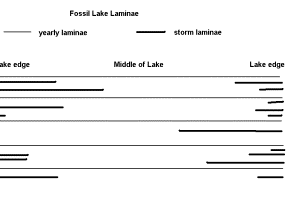
Small storms might not produce much sediment and only produce an additional layer near the shore. This explains Buchheims' observations. Buchheim and Biaggi (1988) were able to measure 1089 laminae in the centre of the basin and 1566 laminae in the basin margin. This is rain-storm laminae plusannual laminae near shore and only annual laminae in basin center. Indeed Buchheim (1994, p. 8), acknowledges this aspect of the problem (but Garner doesn't):
- "Fluvial inflow, rich in calcium, mixed with the alkaline lake water, and calcite was immediately precipitated; a greater amount nearer the margins of the lake. This explains why laminae tend to be thicker nearer the lake margins. Larger inflow events (related to local storms as well as seasonal factors) would result in lake-wide deposition of carbonate laminae, whereas smaller inflow events would result in laminae deposition only nearer the margins. This explains the greater number of laminae per synchronous unit nearer the lake margins."
Note that Buchheim doesn't appeal to an unworkable global flood hypothesis to explain the difference in the number of varves. Elsewhere Buchheim and Loewen present geochemical evidence that the edges of Fossil Lake were less saline than the center. This is as it should be if Fossil Lake were really a lake rather than a global flood deposit. They write (Buchheim and Loewen,2001, p. 1116):
- "The vertical trends in the dolomite-dominated upper unit are complicated by lateral facies trends that indicate a lateral salinity-gradient. The facies trends can be identified by calcite-dolomite ratios, stable-isotope ratios, TOC, evaporite content, and paleontologic variations within a single time-synchronous bed. In some beds, laminated dolomicrites and evaporites grade shoreward into laminated and bioturbated calcimicrite containing fossil fish. Carbonate del 18O values decrease shoreward. These features clearly demonstrate a shoreward freshening within Fossil Lake."
One of the most important things in the above is the change in del 18O around the edges of Fossil Lake. This occurs because when water evaporates, molecules containing 16O are preferentially evaporated. This makes rain water higher in 16O and lower in 18O so when it rains, and the rainwater runs into the edges of the lake, the waters along the shore are lower in 18O than those waters further out. Since the water is used by organisms to create the carbonate, organisms along the shore use waters light in 18O. To create this areal pattern in a global flood where the waters are mixed, would be highly improbable.
Even if the laminations of Fossil Lake can't be considered varves, they can't be rapidly deposited. Buchheim found a fossil fish, which had died, been buried in the sediment and then animals burrowed into the sediment through the fish. The picture is below (modified from Buchheim, 1994, Figure 7).
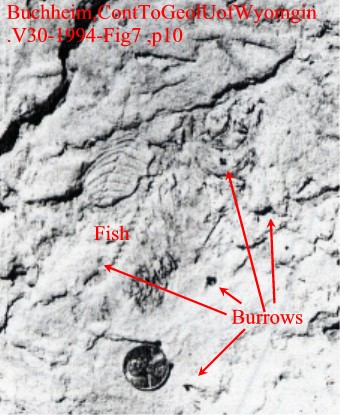
What do the burrows look like in vertical succession? (modified from Buchheim, 1994, Fig 6)
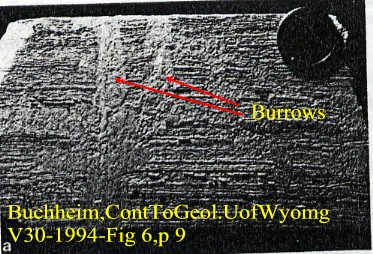
What is clear above, the burrow can't be dug until all the layer it digs through have been deposited. Thus, the burrows show an interruption in the deposition while the burrower digs.
Now, going back to the question of the varves, it must be noted that the center of Lake Gosiute, unlike Fossil Lake, is 100 miles from shore. That far from shore, storm laminae are highly unlikely. Thus, the varves reflect yearly deposition. This is why the data that we see in Gosiute showing long periodicities is so important and not bothered at all by Buchheim's work. But non-geologists don't know that citing Buchheim and Biaggi is really a case of bait and switch.
Here is what it looks like y=yearly layer s=storm layer (from rain runoff)
Shore center of lake yyyyyyyyyyyyyyyyyyyyyyyyyyyyyyyyyyyyyyyyyyyyyyyyyyyyy sssssss yyyyyyyyyyyyyyyyyyyyyyyyyyyyyyyyyyyyyyyyyyyyyyyyyyyyy sssssssssssssssss sssss yyyyyyyyyyyyyyyyyyyyyyyyyyyyyyyyyyyyyyyyyyyyyyyyyyyyy ssssssss yyyyyyyyyyyyyyyyyyyyyyyyyyyyyyyyyyyyyyyyyyyyyyyyyyyyy sssssssssssssssssssssss yyyyyyyyyyyyyyyyyyyyyyyyyyyyyyyyyyyyyyyyyyyyyyyyyyyyy sssssssssssOut in the center of Gosuite, 100 miles from shore, the layers are uniform in thickness but near shore and in the small Fossil lake, the storm layers are found. Out in the center of Gosiute, storm laminae are missing, as they should be.
Now, if that is the case, and the central Gosiute laminae are truly yearly, we should be able to find the signature of the solar cycle and other astronomical parameters in the varve thickness. The reason for this is that the orbital parameters of the earth and the solar cycle itself affect the weather patterns which affect rainfall and temperature. As the rainfall and temperature varies, sediment influx to the lake varies and thus the varve thicknesses vary. Do we find periodic variations in the varve thickness? Yes!
Ripepe, Roberts, and Fischer examined short cores from the middle of Lake Gosiute. They write (1991, p. 1155):
- "On the premise that sequential changes in varve thickness offer a proxy for climatic variations, we investigated varve thickness in three core segments from the distal lacustrine oil shales (Tipton and Laney members) of the Green River Formation, by means of an image analysis program. Of two strong bimodal periodicities one, at 4.8-5.6 years, is interpreted as an El Nino type (ENSO) phenomenon of atmospheric dynamics, while the other, at 10.4-14.7 years, is interpreted as the sunspot cycle, originally recognized in this formation by Bradley (1929,1931). Weaker periodicities may exist at ca.8 and 33 years - the latter also recognized by Bradley. Taken in conjunction with the work of Bradley (1929,1931) and of Crowley et al. (1986), this suggests that some but not all of the oil shale of the Green River Formation is truly varved and can be used to infer climatic time-series."
- " The cyclicities discussed are developed at seven levels. High-frequency cycles in the Tipton and Laney members include the annual cycle expressed in varving (1), the grouping of varves into El Nino (ENSO)-type (5.8) year cycles (2), their grouping into sunspot cycles (3), and their grouping into 30-year cycles(4). Low-frequency cycles from the Milankovitch frequency band are seen in the Tipton and Wilkins Peak members, and include the precessional 20 ka cycle (5) and the ca. 100 ka eccentricity cycle (6). Cycle categories 1,5, and 6 are discussed here, while 2,3 and 4 are dealt with the Ripepe et al."
Such cyclicities are also found in the deposits of Lake Uinta. Crowley, Duchon and Rhi (1986) performed Fourier analyses on cores from there and found both ENSO (5.4 year) and sunspot (10.4 year) cycles. The young-earth creationists simply must ask himself why would God create a flood which would deposit layers with these types of cyclicities. Garner certainly doesn't tell us why. He says: "Creationist geologists need to investigate the issue more closely..." which is clearly true.
But there is one more piece of evidence which confirms that the Green River Formation took millions of years to be deposited. The evidence comes from radioactive dating of the tuffs which are found occasionally in the formation. They represent almost instantaneous events in the geologic column. It only takes a few weeks for most of the ash from a volcano to fall from the air. These tuffs parallel layering. If the Green River was a rapidly deposited formation the ash should be spread out over many many laminae. It isn't. Why do I say that? Because to deposit 30,000 feet of sediment in 1 year requires an average rate of 82 feet per day. The 2,600 feet of Green River for which Bradley calculated the duration, would require 32 days for deposition--thirteen million layers in 32 days. That is a rate of 4.7 layers per second over 40,000 square kilometers. Not only is that an impossible rate and area over which to control the uniformity of deposition, it also violates the laws of physics. As we saw above, Stokes Law determines how rapidly the sedimentary particles can fall through the water column and they can't fall fast enough to make 4.7 layers per second. Remember it takes the carbonate particles a day to fall 6 feet (1.9 meters).
If on the other hand, the laminae are yearly, then the depositional rates measured by the dating should match the average yearly varve thickness. What do we find?
O'Neill (1980) and Bryant (1989) have dated the tuffs and their data can be used to determine the average sedimentation rate. O'Neill (1980) reports the following information on the pages of his thesis listed at the right:
| Tuff #6 |
46.5 m.y. |
p. 126-127 |
| Big Island Tuff |
49.4 +/- .4 m.y. |
p. 50 |
One should note that 150 feet separates the two tuffs.
We can calculate a sedimentation rate of .0157 mm per year. This is not far off of the rates for the rich oil shale cited by Bradley. Thus both radioactive dating and sedimentological analysis, and Fourier analysis indicate that the Green River Formation took millions of years to be deposited.
The upper part of the Green River formation contains tuffs, the lower portion doesn't. Bryant has dated a series of tuffs from the Uinta part of the Green River. He started with tuffs well above the Green River in the Duchesne formation which overlies the Uinta formation, which in turn overlies the Green River. The column looks like:
Duchesne River Fm
Duchesne River Fm
| Starr flat mbr |
32.2 myr +/- 2.8 |
| 36.7 myr +/- 3.9 |
|
| Lapoint Fm |
28.7 myr +/- 2.0 |
| 33.7 myr +/- 5.6 |
|
| 32.9 myr +/- 4.5 |
|
| Dry Gulch Creek mbr |
33.0 myr +/- 3.4 |
| 34.5 myr +/- 4.4 |
Green River fm
| Sandstone facies |
37.6 myr +/- 1.9 |
Saline facies
| Main body |
43.9 myr +/- 5.4 |
| 42.3 myr +/- 2.0 |
But when tuffs from the larger stratigraphic section are examined, one clearly sees that, in general, the radioactive dates get older as one goes lower in the local stratigraphy The +/- are the error bars on the radioactive date. So before you say that the dates are 'out of order' realize that the error bar means that there is a 68% chance that the true date lies between the age one standard deviation below and one above. For the 33.7 myr +/- 5.6 myr means that there is a 68% chance that the true age lies between 39.3 and 28.1 Myr.
When we focus in on the Green River, there is 600 meters separating the 37.6 myr date from the level of the 43.9 million year date (Bryant, 1989, p. J12). That is an average depositional rate of .1 mm per year. Once again, radioactive dating supports the concept that the laminations are yearly varves.
Post-Flood?
Lest someone think that the Green River Formation can be claimed to be post-Flood, which is a tactic often taken by creationists when facing a terrible difficulty, this tactic won't solve their problems. Allowing for 4,000 years to deposit the Green river means that 8.9 layers per day must be deposited for that entire time (there are 13 million laminae and 1.46 million days in 4,000 years). The young-earth creationists can not point to anywhere on modern earth where laminae of this type are being formed that rapidly over such a large area. Claims that the Green River might be post flood also require someone to decide where the flood/post-flood boundary is in the geologic column of Wyoming. No young-earther has defined this boundary in any satisfactory basis.
Conclusion
Every feature of the Green River formation points to long periods of deposition. The coprolites of fish and birds, algal encrusting of logs, footprints, variations in laminae thickness consistent with known weather patterns, sunspots, and Earth orbital parameters. Radioactive dating confirms the depositional rates which indicate yearly varves. The young-earth creationist, like Garner, can sit on the fence and throw rocks at the geological explanation, but he can't explain any of these features. The young-earth creationist must ask himself the following set of questions if he is to be rational.
1. Why were the flood waters on layer after layer the depth of a bird leg as indicated by the footprints?
2. How were catfish able to leave so many coprolites on the layers if this is a rapidly deposited formation?
3. Why would God imprint orbital parameters and sunspot cycles on the thicknesses of the laminae?
4. Why do the radioactive dates seem to verify the slow depositional rates?
5. How could a bird take the time to nibble the lake floor during a global flood?
6. How are raindrop impressions preserved under the waters of a global flood?
7. Why did God produce a flood deposit which exactly matches the areal distribution seen in lakes? Did God deceive us?
8. Why do the oxygen-18 values decrease around the edges of Fossil Lake as would be expected of a modern lake?
9. The young-earth creationist must also ask him- or herself why the young-earth authors never tell him what I just told him.
References
Bradley, Wilmot H., 1929, "Varves and Climate of the Green River Epoch," in USGS Professional Paper 158, p. 87-110
Bryant, Bruce, et al, 1989, "Upper Cretaceous and Paleogene Sedimentary Rocks and Isotopic Ages of Paleogene Tuffs, Uinta Basin Utah," USGS Bulletin 1787-J,K
Buchheim, Paul, 1994, "Paleoenvironments, Lithofacies and Varves of the Fossil Butte Member of the Eocene Green River Formation, Southwestern Wyoming," Contributions to Geology, University of Wyoming, 30:1:3-14.
Buchheim Paul H., and Robert Biaggi, "Laminae Counts Within a Synchronous Oil Shale Unit: A Challenge to the "Varve Concept," article No. 18279 referenced in GSA ABSTRACTS & PROGRAMS, 1988, v. 20, no. 7, pg. 317
Buchheim, Paul H., and Mark A. Loewen, 2001, "The Climate of Eocene Fossil Lake (Green River Formation, Wyoming) as determined from Vertical and Lateral Facies Trends," AAPG Bulletin, 85:6:1116
Buchheim, Paul, and Ronald C. Surdam, 1997, "Fossil Catfish and the Depositional Environment of the Green River Formation, Wyoming," Geology, 5:196-198.
Cotton, Gerald E. et al, 1987, "Preservation of Human Tissue Immersed for Five Years in Fresh Water of Known Temperature," Journal of Forensic Sciences, 32:4:1125-1130
Crowley, Kevin D., and Claude E. Cuchon and Jaeyoung Rhi, 1986, "Climate Record in Varved Sediments of the Eocene Green River Formation," Journal of Geophysical Research, 91:D8:8637-8647.
Drysdale, Russell N., 1999, "The Sedimentological Significance of Hydropsychid Caddis-Fly Larvae (Order: Trichoptera) in a Travertine-Depositing Stream: Louie Creek, Northwest Queensland, Australia," Journal of Sedimentary Research, 69:1:145-150.
Erickson, Bruce, 1967, "Fossil Bird Tracks from Utah," Museum Observer, reprinted in William A. S. Sarjeant Terrestrial Trace Fossils, (Stroudsburg: Hutchinson Ross Publishing Co., 1983), p. 140-146.
Fischer, Alfred G., and Lillian T. Roberts, 1991, "Cyclicity in the Green River Formation (Lacustrine Eocene) of Wyoming," Journal of Sedimentary Petrology, 61:7:1146-1154
Garner, Paul, 1997, "Green River Blues," Creation, 19:(3):18-19
Grande, Lance, and H. Paul Buchheim, May, 1994, "Paleontological and Sedimentological Variation in Early Eocene Fossil Lake," Contributions to Geology, University of Wyoming, V. 30
Leggitt, V. Leroy, and Robert A. Cushman, Jr., 2001, "Complex Caddisfly-dominated bioherms from the Eocene Green River Formation," Sedimentary Geology, 45:377-396
Leggitt, V. Leroy, Paul H. Buchheim, and Robert E. Biaggi, 1998, "The Stratigraphic Setting of ThreePresbyornis Nesting Sites: Eocene Fossil Lake, Lincoln County, Wyoming," in Vincent Santucci and Lindsay McClelland, editors National Park Service Paleontological Research, NPS/NRGRD/GRDTR-98/01
National Park Service Technical Report http://www.aqd.nps.gov/grd/geology/paleo/pub/grd3_3/fobu2.htm
McGrew, Paul O., and Alan Feduccia 1973, "A Preliminary Report on a Nesting Colony of Eocene Birds"25th Field Conference Wyoming Geological Association Guidebook, pp 163-165
McPeek, L. A., 1981. "Eastern Green River Basin: A Developing Giant Gas Supply from Deep, Overpressured Upper Cretaceous Sandstones," AAPG Bulletin, 65:1078-1098.
Moussa, Mounir T., 1968, "Fossil Tracks from the Green River Formation (Eocene), Near Soldier Summit, Utah," Journal of Paleontology, 42:6:1433-1478.
O'Neill, William Arthur, 1980 "40Ar 39Ar ages of Selected tuffs of the Green River Formation: Wyoming, Colorado, and Utah." M.S. Thesis, Ohio State University.
Ripepe, Maurizio, Lillian T. Roberts, and Alfred G. Fischer, 1991, "Enso and Sunspot Cycles in Varved Eocene Oil Shales from Image Analysis," Journal of Sedimentary Petrology, 61:7:1155-1163
Did you know that you can be a Christian,
and believe that the earth is billions of years old? The
author of this article, Glenn Morton, made the transition from young
earth creationism to old earth creationism. To learn more
about old earth creationism, see
Old Earth Belief,
or check out the article
Can You Be A
Christian and Believe in an Old Earth?
Feel free to check out more of this website. Our goal is to
provide rebuttals to the bad science behind young earth creationism,
and honor God by properly presenting His creation.
